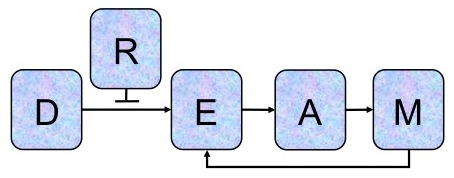Guest blog post from Gustavo Solovitzky, chair of the DREAM7 conference and the DREAM project, which has partnered with Open Network Biology, BioMed Central’s new open access journal publishing predictive, network-based models. One of the goals of the DREAM challenges has been to task researchers with deducing network models from complex data.
 On June 12, 2012 we launched the 7th edition of the Dialogue on Reverse Engineering Assessment and Methods also known as the DREAM7 Challenges. What started in 2006 as an effort to understand the strengths and limitations of various methods for the reverse engineering of biological networks from high-throughput data has evolved into yearly challenges that invite the scientific community to think together about a diverse set of open quantitative biology problems.
On June 12, 2012 we launched the 7th edition of the Dialogue on Reverse Engineering Assessment and Methods also known as the DREAM7 Challenges. What started in 2006 as an effort to understand the strengths and limitations of various methods for the reverse engineering of biological networks from high-throughput data has evolved into yearly challenges that invite the scientific community to think together about a diverse set of open quantitative biology problems.
This year the DREAM project has called for participation and submission of predictions to the following challenges:
Network Topology and Parameter Inference Challenge –Developed in collaboration with Prof. H. Sauro’s group at University of Washington, this challenge invites researchers to infer the topology and the kinetic parameters of synthetic (i.e. simulated) gene regulatory networks. Participants will be able to use credits to “buy” experiments that are most informative for their inference. This challenge is designed to test participants’ ability to design experiments that best match their algorithmic methods. Deadline for submission of solutions: October 1st, 2012.
Sage Bionetworks-DREAM Breast Cancer Prognosis Challenge – Developed in collaboration with the non-profit organization Sage Bionetworks, this challenge asks researchers to predict overall survival in patients with breast cancer. Deadline for submission of solutions: November 1st, 2012.
DREAM Phil Bowen ALS Progression Prediction Prize4Life Challenge – Developed in collaboration with the non-profit organization Prize4Life, researchers are asked to predict the progression of ALS in Lou Gehrig’s disease patients. Deadline for submission of solutions: October 15, 2012
NCI-DREAM Drug Sensitivity Prediction Challenge – Developed in collaboration with the NCI, researchers are invited to predict the sensitivity of a panel of cell lines to chemotherapeutic compounds whose effect in other cell lines is known. Deadline for submission of solutions: October 1st, 2012.
Best performers will receive a host of awards:
1) A speaking invitation and travel expenses to the DREAM7 conference (Nov 12-16, San Francisco) will be provided for one member of the best performing team for each challenge. 
2) Our partner journal Open Network Biology will waive the article processing charge (an award of £1200GBP per paper) and publish the best performing methods after challenge-assisted peer review.
3) Science Translational Medicine has agreed to publish the a paper by the best performing team in the Sage Bionetworks-DREAM Breast Cancer Prognosis Challenge, (after a challenge-assisted peer review) as a "prize" for best performance.
4) The non-for-profit foundation Prize4Life, our partner in the DREAM-Phil Bowen ALS Prediction Challenge, will offer a reward of $25,000 for the best performing submission.
5) The National Cancer Institute intends to support the subsequent experimental validation and development of the top performing models in the NCI-DREAM Drug Sensitivity Prediction Challenge.
6) The best performing team in the NCI-DREAM Drug Sensitivity Prediction Challenge will be offered the opportunity to publish (after challenge-assisted peer review) their results in Nature Biotechnology as a "prize" for outstanding performance.
All submitted predictions are tested against a “ground truth” that was previously unseen by the participants and which is based on unpublished data. This ensures an objective assessment of all submitted models and allows for the identification of accurate methods to solve the given problems. In cases for which accurate methods do not exist, the challenge helps garner evidence against the validity of the initial hypothesis that such problem can be solved with the existing data. Conversely, if at least one member of the community solves it, then the hypothesis can be considered verified.
Besides establishing a set of “best practices” in systems biology, the DREAM challenges enable a dialogue in the scientific community around why an analytical tool yields good or bad results. The outcomes of DREAM have the potential to complement the time-honored peer-review process and enhance the confidence of the scientific community on biological models and algorithm reliability. Since theoretical, computational and experimental scientists look at the data from different perspectives, fostering collaboration between them has the potential to bring deeper insights into the biology behind a challenge.
Best performers will be invited to present their work at the DREAM 7 Conference in San Francisco on 12 – 15 November 2012. For more details on the challenges and prizes click here.
Dr Gustavo Stolovitzky, IBM Computational Biology Center
Comments